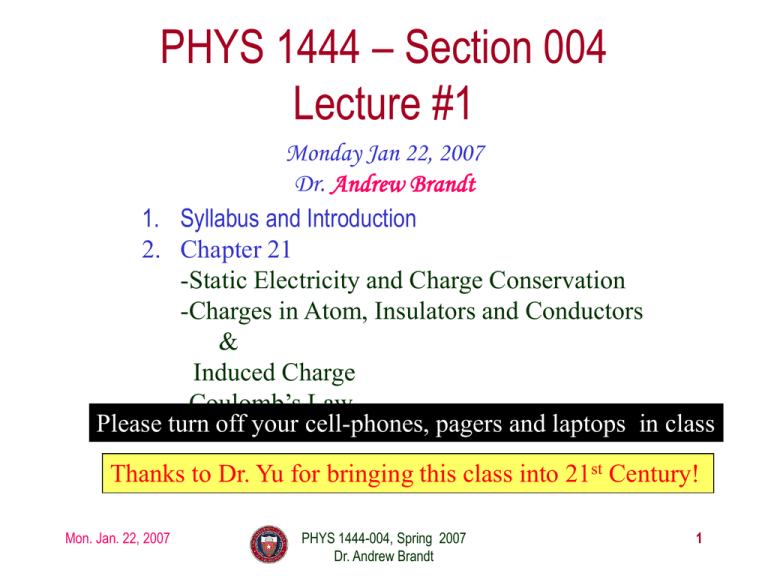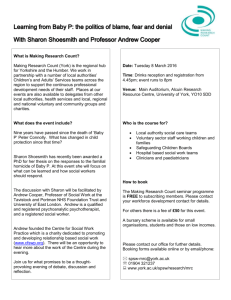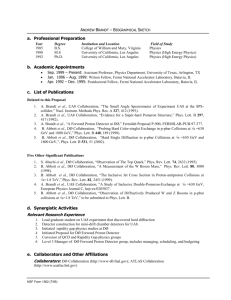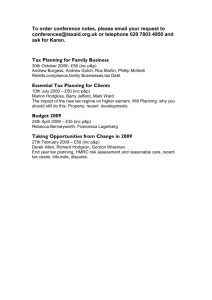PHYS 1443 – Section 501 Lecture #1
advertisement

PHYS 1444 – Section 004
Lecture #1
Monday Jan 22, 2007
Dr. Andrew Brandt
1. Syllabus and Introduction
2. Chapter 21
-Static Electricity and Charge Conservation
-Charges in Atom, Insulators and Conductors
&
Induced Charge
-Coulomb’s Law
Please turn off your cell-phones, pagers and laptops in class
Thanks to Dr. Yu for bringing this class into 21st Century!
Mon. Jan. 22, 2007
PHYS 1444-004, Spring 2007
Dr. Andrew Brandt
1
Who am I?
•
•
•
•
Name: Andrew Brandt (You can call me Dr. Brandt)
Office: Rm 344, CPB (Physics and Chemistry Building)
Extension: x2706, E-mail: brandta@uta.edu
Education: B.S. Physics/Economics College of William and Mary
1985; Ph. D. 1992 UCLA
• My Research Area: High Energy Physics (HEP)
– Collide particles (currently protons and anti-protons) at energies
equivalent to 10 Quadrillion degrees
– To understand
• Fundamental constituents of matter
• Interactions or forces between the constituents
– A pure scientific research activity
• Applied use of the fundamental laws not always obvious, but use of discovery
of electron was not immediately known either!
• Indirect product of research contribute to every day lives; eg. WWW
Mon. Jan. 22, 2007
PHYS 1444-004, Spring 2007
Dr. Andrew Brandt
2
Structure of Matter
Matter
Molecule
Atom
Nucleus
Baryon
Quark
(Hadron)
u
10-14m
10-9m
10-10m
10-2m
Condensed matter/Nano-Science/Chemistry
Atomic Physics
Nuclear
Physics
10-15m
protons, neutrons,
mesons, etc.
p,W,L...
<10-19m
top, bottom,
charm, strange,
up, down
Electron
(Lepton)
<10-18m
High Energy Physics
Mon. Jan. 22, 2007
PHYS 1444-004, Spring 2007
Dr. Andrew Brandt
3
The Standard Model
• Assumes the following fundamental structure:
Discovered
in 1995
Directly
observed in
2000
Mon. Jan. 22, 2007
PHYS 1444-004, Spring 2007
Dr. Andrew Brandt
4
Fermilab Tevatron and LHC at CERN
• Present Highest Energy protonanti-proton collider
• World’s Highest Energy protonproton collider in 2 years
– Ecm=1.96 TeV (=6.3x10-7J/p
13M Joules on 10-4m2)
Equivalent to the kinetic energy of
a 20t truck at a speed 80 mi/hr
– Ecm=14 TeV (=44x10-7J/p
1000M Joules on 10-4m2)
Equivalent to the kinetic energy of
a 20t truck at a speed 212 mi/hr
Chicago
CDF
p
Tevatron
Mon. Jan. 22, 2007
DØ
p
PHYS 1444-004, Spring 2007
Dr. Andrew Brandt
5
DØ Detector: Run II
30’
50’
Mon. Jan. 22, 2007
PHYS 1444-004, Spring 2007
Dr. Andrew Brandt
• Weighs 5000 tons
• Can inspect
3,000,000
collisions/second
• Records 50
collisions/second
• Records ~12.5M
Bytes/second
• Will record 2 Peta
bytes in the
current run.
• Has over a 100
million parts
6
Highest ET dijet event at DØ
CH
hadrons
FH
EM
p
K
Time
“parton jet” “particle jet” “calorimeter jet”
How does an Event Look in a Collider Detector?
q
g
E1T 475 GeV, 1 0.69
p
p
Mon. Jan. 22, 2007
q
E1T 472 GeV, 2 0.69
PHYS 1444-004, Spring 2007
Dr. Andrew Brandt
7
High Energy Art
Mon. Jan. 22, 2007
PHYS 1444-004, Spring 2007
Dr. Andrew Brandt
8
Forward Proton Detector Layout
p
p
D2
D1
59
57
D
A2
33
S
Q4 Q3 Q2
Q2 Q3 Q4
A1
Veto
23
0
P1U
S
P1D
23
P2O
P2I
33
Z(m)
UTAgraduate
studentcomprised
Michael of
Strang
•Former
9 momentum
spectrometers
18
Roman Pots
• Scintillating fiber detectors (built at UTA) are
moved close (~6 mm) to the beam to track
scattered protons and anti-protons
• Reconstructed track is used to calculate
momentum and scattering angle, covering new
kinematic regions
• Allows combination of tracks with high momentum
scattering in the central detector
Mon. Jan. 22, 2007
PHYS 1444-004, Spring 2007
Dr. Andrew Brandt
9
Fast Timing Detectors for ATLAS
WHO?
WHY?
UTA (Brandt), Alberta, Louvain, FNAL
Background Rejection
Ex, Two protons from one interaction and two b-jets from another
proton
Use timing to measure vertex
How?
How Fast?
Mon. Jan. 22, 2007
10 picoseconds (light travels 3mm in 10 psec!)
PHYS 1444-004, Spring 2007
Dr. Andrew Brandt
10
Primary Web Page
http://www-hep.uta.edu/~brandta/teaching/sp2007/teaching.html
Mon. Jan. 22, 2007
PHYS 1444-004, Spring 2007
Dr. Andrew Brandt
11
Grading
• Exams: 50%
–
–
–
–
Best two of three exams (2 midterms + final)
Comprehensive final
Exams will be curved if necessary
No makeup tests
• Homework: 20% (no late homework)
• Pop quizzes10%
• Lab score: 20%
Mon. Jan. 22, 2007
PHYS 1444-004, Spring 2007
Dr. Andrew Brandt
12
Homework
• Solving homework problems is the best (only?) way to
comprehend class material
• An electronic homework system has been setup for you
– Details are in the syllabus and on web (class id 14445
everyone needs their own UT EID)
– https://hw.utexas.edu/
– 2 points extra credit on final HW grade if registered by class 1/24/07, 1 point
if 1/29/07 (first hw on Ch. 21 will be due Wednesday 1/31/07 at 12 pm)
• Each homework carries the same weight
• Your lowest two homework scores will be dropped
• Home work will constitute 20% of the total A good way of
keeping your grades high
• Allowed (encouraged) to work with others and get help from
physics clinic as needed—always attempt homework first on your
own, or you will likely pay for it on the tests (DON’T COPY!)
Mon. Jan. 22, 2007
PHYS 1444-004, Spring 2007
Dr. Andrew Brandt
13
Getting Started with On-line Homework
STEP 1: Go to the Homework Service
at the URL https://hw.utexas.edu/
Select the link
Register yourself in your class
Unique number: 14445
STEP 2: Return to https://hw.utexas.edu/
Download: Students' Instructions
Download: First Homework
STEP 3: Work one question and submit its answer
before the next class period.
STEP 4: Continue submitting answers until due time.
STEP 5: Download solutions after due time.
Mon. Jan. 22, 2007
PHYS 1444-004, Spring 2007
Dr. Andrew Brandt
14
Homework Scoring
VII. Scoring
a) Multiple-choice questions
A randomly guessing student should, on average, receive the same score as a student who does
not answer. Our multiple-choice scoring scheme corrects for random guessing by giving
negative scores for incorrect answers. (The SAT does this also.) This scheme makes
haphazard guessing a waste of time, which will not improve (or help) your score over the long run.
If you are not sure of the correct answer, but you can eliminate one or more of the choices as
wrong, you increase your chances of selecting the correct answer. Statistically, it is to your
advantage to answer such a question.
b) Numeric questions
For more than one try, the full credit score is multiplied by 0.93 ^ (t - 1), where "t" is the number
of tries that you use, and the "^" is notation for "to the power of." (Note: 0.93 ^ 0 = 1.)
maximum of 7
Mon. Jan. 22, 2007
PHYS 1444-004, Spring 2007
Dr. Andrew Brandt
15
Attendance and Class Style
• Attendance:
– is STRONGLY encouraged, but I will not generally
take attendence
• Class style:
– Lectures will be primarily on electronic media
• The lecture notes will be posted AFTER each class
– Will be mixed with traditional methods
– Active participation through questions and
discussion are STRONGLY encouraged
Mon. Jan. 22, 2007
PHYS 1444-004, Spring 2007
Dr. Andrew Brandt
16
Why Do Physics?
{
• To understand nature through experimental
Exp. observations and measurements (Research)
• Establish limited number of fundamental laws, usually
Theory with mathematical expressions
• Explain and predict nature
⇒Theory and Experiment work hand-in-hand
⇒Theory generally works under restricted conditions
⇒Discrepancies between experimental measurements
and theory are good for improvement of theory
⇒Modern society is based on technology derived from
detailed understanding of physics
{
Mon. Jan. 22, 2007
PHYS 1444-004, Spring 2007
Dr. Andrew Brandt
17
What do you want from this class?
I want an “A”
•
•
•
•
I just want to pass!
I want you to:
Understand fundamental principles of E&M
Learn how to do research and analyze what you
observe
Learn how to express observations and
measurements in mathematical language
Learn how solve problems
Mon. Jan. 22, 2007
PHYS 1444-004, Spring 2007
Dr. Andrew Brandt
18
Brief History of Physics
• AD 18th century:
– Newton’s Classical Mechanics: A theory of mechanics based on
observations and measurements
• AD 19th Century:
– Electricity, Magnetism, and Thermodynamics
• Late AD 19th and early 20th century (Modern Physics Era)
– Einstein’s theory of relativity: Generalized theory of space, time, and energy
(mechanics)
– Quantum Mechanics: Theory of atomic phenomena (small distance scales)
• Physics has come very far, very fast, and is still progressing, yet
we’ve got a long way to go
–
–
–
–
What is matter made of?
How does matter get mass?
How and why do particles interact with each other?
How is universe created?
Mon. Jan. 22, 2007
PHYS 1444-004, Spring 2007
Dr. Andrew Brandt
19
Need for Standards and Units
• Three basic quantities for physical measurements
– Length, Mass, and Time
• Need a language so that people can understand each
other (How far is it to Chicago? 1000)
• Consistency is crucial for physical measurements
– The same quantity measured by one person must be
comprehensible and reproducible by others
• A system of unit called SI (System International)
established in 1960
– Length in meters (m)
– Mass in kilo-grams (kg)
– Time in seconds (s)
Mon. Jan. 22, 2007
PHYS 1444-004, Spring 2007
Dr. Andrew Brandt
20
SI Base Quantities and Units
Quantity
Length
Time
Mass
Electric current
Temperature
Amount of substance
Luminous Intensity
Mon. Jan. 22, 2007
Unit
Meter
Second
Kilogram
Ampere
Kelvin
Mole
Candela
PHYS 1444-004, Spring 2007
Dr. Andrew Brandt
Unit Abbrevation
m
s
kg
A
k
mol
cd
21
Prefixes and their meanings
•
•
•
•
•
•
•
•
deca (da): 101
hecto (h): 102
kilo (k): 103
mega (M): 106
giga (G): 109
tera (T): 1012
peta (P): 1015
exa (E): 1018
Mon. Jan. 22, 2007
•
•
•
•
•
•
•
•
deci (d): 10-1
centi (c): 10-2
milli (m): 10-3
micro (m): 10-6
nano (n): 10-9
pico (p): 10-12
femto (f): 10-15
atto (a): 10-18
PHYS 1444-004, Spring 2007
Dr. Andrew Brandt
22
Examples 1.3 and 1.4 for Unit Conversions
• Ex 1.3: A silicon chip has an
area of 1.25in2. Express this
in cm2.
2.54 cm
1.25 in 2 1.25 in 2
1
i
n
2
6
.
45
cm
2
1.25 in
2
1 in
2
1.25 6.45 cm 2 8.06 cm 2
• Ex 1.4: Where the posted speed limit is 65 miles per hour (mi/h or mph), what is this
speed (a) in meters per second (m/s) and (b) kilometers per hour (km/h)?
12 in 2.54 cm 1 m
1 mi= 5280 ft
1609 m 1.609 km
1 ft 1 in 100cm
1609 m 1 1 h
(a) 65 mi/h 65 mi
29.1 m/s
1 mi 1 h 3600 s
Oops, what
1.609 km 1
104 km/h
(b) 65 mi/h 65 mi
about sig. figs.?
1 mi 1 h
Mon. Jan. 22, 2007
PHYS 1444-004, Spring 2007
Dr. Andrew Brandt
23
Uncertainties
• Physical measurements have limited precision,
no matter how good they are, due to:
Statistical { Number of measurements
Quality of instruments (meter stick vs micrometer)
Systematic
Experience of the person doing measurements
Etc.
{
In many cases, uncertainties are more important and
difficult to estimate than the central (or mean) values
Mon. Jan. 22, 2007
PHYS 1444-004, Spring 2007
Dr. Andrew Brandt
24
Significant Figures
• Significant figures denote the precision of the
measured values
– Significant figures: non-zero numbers or zeros that are
not place-holders
• 34 has two significant digits; 34.2 has 3; 0.001 has one
because the 0’s before 1 are place holders, 34.100 has 5,
because the 0’s after 1 indicates that the numbers in these
digits are indeed 0’s.
• When there are many 0’s, use scientific notation:
– 31400000=3.14x107
– 0.00012=1.2x10-4
Mon. Jan. 22, 2007
PHYS 1444-004, Spring 2007
Dr. Andrew Brandt
25
Significant Figures
• Operational rules:
– Addition or subtraction: Keep the smallest number of decimal
places in the result, independent of the number of significant
digits: 34.001+120.1=154.1
– Multiplication or Division: Keep the number of significant
figures of the operand with the least S.F. in the result:
34.001x120.1 = 4083, because the smallest number of
significant figures is 4.
– For homework service keep 4 figures to be on the safe side
Mon. Jan. 22, 2007
PHYS 1444-004, Spring 2007
Dr. Andrew Brandt
26
Static Electricity; Electric Charge and
Its Conservation
• Electricity is from Greek word elecktron=amber, a petrified
tree resin that attracts matter if rubbed
• Static Electricity: an amber effect
– An object becomes charged or “posses a net electric charge”
due to rubbing
– Example: Rub feet on carpet and zap your little sister
• Two types of electric charge
– Like charges repel while unlike charges attract
– Benjamin Franklin referred to the charge on a
glass rod as the positive, arbitrarily. Thus the
charge that attracts a glass rod is negative.
This convention is still used.
Mon. Jan. 22, 2007
PHYS 1444-004, Spring 2007
Dr. Andrew Brandt
27
Static Electricity; Electric Charge and
Its Conservation
• Franklin argued that when a certain amount of charge is
produced on one body in a process, an equal amount of
opposite type of charge is produced on another body.
– The positive and negative are treated algebraically so that during any
process the net change in the amount of produced charge is 0.
• When you comb your hair with a plastic comb, the comb acquires a negative
charge and the hair an equal amount of positive charge.
• This is the law of conservation of electric charge.
– The net amount of electric charge produced in any process is
ZERO!!
• If one object or one region of space acquires a positive charge, then an equal
amount of negative charge will be found in neighboring areas or objects.
• No violations have ever been observed.
• This conservation law is as firmly established as that of energy or momentum.
Mon. Jan. 22, 2007
PHYS 1444-004, Spring 2007
Dr. Andrew Brandt
28
Electric Charge in the Atom
• It has been understood through the past century that an atom
consists of
– A positively charged heavy core What is the name?
• This core is nucleus and consists of neutrons and protons.
– Many negatively charged light particles surround the core What
is the name of these light particles?
• These are called electrons
• How many of these?
As many as the number of protons!!
• So what is the net electrical charge of an atom?
– Zero!!! Electrically neutral!!!
• Can you explain what happens when a comb is rubbed on a
towel?
– Electrons from towel get transferred to the comb, making the comb
negatively charged while leaving positive ions on the towel.
– These charges eventually get neutralized primarily by water
molecules in the air.
Mon. Jan. 22, 2007
PHYS 1444-004, Spring 2007
Dr. Andrew Brandt
29
Insulators and Conductors
• Let’s imagine two metal balls, one of which is charged
• What will happen if they are connected by
– A metallic object?
• Charge is transferred, until the charge is evenly distributed
• These objects are called conductors of electricity.
– A wooden object?
• No charge is transferred
• These objects are called nonconductors or insulators.
• Metals are generally good conductors whereas most other
materials are insulators.
– A third kind of materials called semi-conductors, like silicon or
germanium conduct only in certain conditions
• Atomically, conductors have loosely bound electrons while
insulators have tightly bound electrons!
Mon. Jan. 22, 2007
PHYS 1444-004, Spring 2007
Dr. Andrew Brandt
30
Induced Charge
• When a positively charged metal object is brought
close to an uncharged metal object
– If the objects touch each other, the free electrons in the
neutral ones are attracted to the positively charged
object and some will pass over to it, leaving the neutral
object positively charged.
– If the objects get close, the free electrons in the neutral
object still move within the metal toward the charged
object leaving the opposite end of the object positively
charged.
• The charges have been “induced” in the opposite ends of the
object.
Mon. Jan. 22, 2007
PHYS 1444-004, Spring 2007
Dr. Andrew Brandt
31
Induced Charge
ground
• We can induce a net charge on a metal object by
connecting a wire to ground.
– The object is “grounded” or “earthed”.
• Since it is so large and conducts, the Earth can give or
accept charge.
– The Earth acts as a reservoir for charge.
• If the negative charge is brought close to a neutral metal
rod
– Positive charges in the neutral rod will be attracted by the
negatively charged metal.
– The negative charges in the neutral metal will gather on the
opposite side, transferring through the wire to the Earth.
– If the wire is cut, the metal bar has net positive charge.
• An electroscope is a device that can be used for
measuring charge
– How does this work?
Mon. Jan. 22, 2007
PHYS 1444-004, Spring 2007
Dr. Andrew Brandt
32
Coulomb’s Law
• Charges exert force to each other. What factors affect the
magnitude of this force?
• Charles Coulomb figured this out in 1780’s.
• Coulomb found that the electrical force is
– Proportional to the product of the two charges
• If one of the charges is doubled, the force doubles.
• If both of the charges are doubled, the force quadruples.
– Inversely proportional to the square of the distances between them.
– Electric charge is a fundamental property of matter, just like mass.
• How would you put the above into a formula?
Mon. Jan. 22, 2007
PHYS 1444-004, Spring 2007
Dr. Andrew Brandt
33
Coulomb’s Law – The Formula
Q11
Q22
Q
F
2
r
Formula
Q1Q2
F k
2
r
• Is Coulomb force a scalar quantity or a vector quantity? Unit?
– A vector quantity. Newtons
• Direction of electric (Coulomb) force is always along the line joining
the two objects.
– If two charges have the same sign: forces are directed away from each other.
– If two charges are of opposite sign: forces are directed toward each other.
• Coulomb force is precise to 1 part in 1016.
• Unit of charge is called Coulomb, C, in SI.
• The value of the proportionality constant, k, in SI
unit is k 8.988 109 N m2 C 2
• Thus, if two 1C charges were placed 1m apart
Mon.
22, 2007
Spring 2007
theJan.
force
would be 9x109N. PHYSDr.1444-004,
Andrew Brandt
34
Announcements
• Reading assignment #1: Read Ch. 21 and
Appendix A by Wes., Jan. 24
• Remember to register for homework service
• No programmable calculators or cell phones
allowed in class on test dates
Mon. Jan. 22, 2007
PHYS 1444-004, Spring 2007
Dr. Andrew Brandt
35







